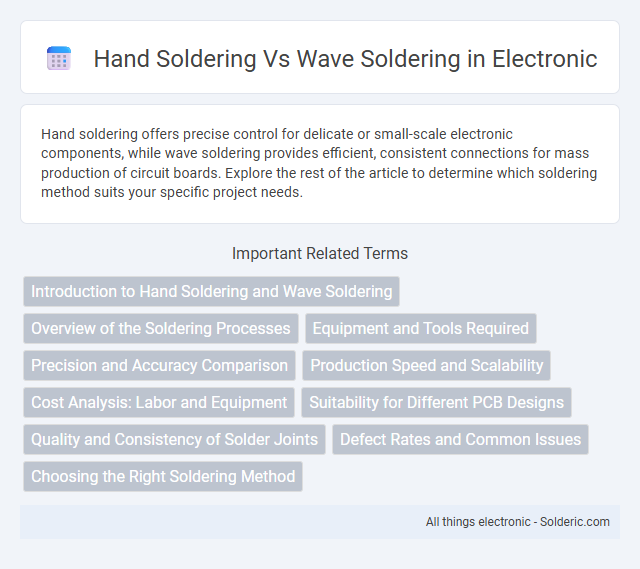Hand soldering offers precise control for delicate or small-scale electronic components, while wave soldering provides efficient, consistent connections for mass production of circuit boards. Explore the rest of the article to determine which soldering method suits your specific project needs.
Comparison Table
| Aspect | Hand Soldering | Wave Soldering |
|---|---|---|
| Process | Manual soldering of components using a soldering iron. | Automated soldering using a wave of molten solder. |
| Suitable For | Prototyping, small batches, repairs. | Mass production of through-hole components. |
| Speed | Slow, dependent on operator skill. | Fast, consistent process. |
| Precision | High precision for specific joints. | Less precise, best for bulk soldering. |
| Labor Cost | High due to manual effort. | Low, automated process. |
| Equipment Cost | Low, requires soldering irons and basic tools. | High, involves specialized wave soldering machines. |
| Defects | Common defects: cold joints, bridging from operator error. | Common defects: solder bridging, insufficient solder due to machine settings. |
| Application | Best for small-scale, customized soldering tasks. | Ideal for large-scale PCB assembly with through-hole technology. |
Introduction to Hand Soldering and Wave Soldering
Hand soldering involves manually applying solder to electronic components using a soldering iron, offering precise control ideal for small-scale or prototype assembly. Wave soldering is an automated process where PCB assemblies pass over a wave of molten solder, enabling efficient mass production of through-hole components. Your choice depends on production volume, precision needs, and assembly complexity.
Overview of the Soldering Processes
Hand soldering involves manually applying solder to electronic components using a soldering iron, ideal for small-scale or precision tasks requiring individual attention. Wave soldering uses a conveyor system to pass printed circuit boards (PCBs) over a wave of molten solder, enabling efficient and uniform soldering of multiple joints simultaneously in high-volume production. Both techniques serve distinct purposes, with hand soldering excelling in customization and repair, and wave soldering optimizing mass assembly.
Equipment and Tools Required
Hand soldering requires a soldering iron, solder wire, flux, and often magnification tools for precision work on small electronic components. Wave soldering involves a conveyor system, a solder pot with molten solder, flux application equipment, and preheating stations, enabling mass soldering of printed circuit boards efficiently. Equipment costs and maintenance are higher for wave soldering due to its automation and scale, while hand soldering tools are more affordable and suitable for prototypes or repair tasks.
Precision and Accuracy Comparison
Hand soldering offers superior precision and accuracy for intricate components and delicate assemblies due to direct manual control, making it ideal for small-scale or prototype work. Wave soldering excels in consistent solder application over large volumes, ensuring uniformity but with less fine-tuned accuracy on individual connections. Your choice depends on the balance between the need for detailed precision and the efficiency required for mass production.
Production Speed and Scalability
Hand soldering offers limited production speed and is ideal for small-scale or prototype manufacturing due to its manual nature and precision requirements. Wave soldering significantly increases production speed by simultaneously soldering multiple components, making it highly scalable for large-volume PCB assembly. Your choice depends on balancing the need for rapid throughput with the flexibility and control of manual soldering methods.
Cost Analysis: Labor and Equipment
Hand soldering involves higher labor costs due to its manual nature, requiring skilled technicians and longer production times per unit. Wave soldering demands significant upfront investment in specialized machinery but offers lower per-unit labor costs through automation and faster throughput. Overall, hand soldering suits low-volume production with flexible labor allocation, whereas wave soldering is cost-effective for high-volume manufacturing with consistent quality and reduced labor expenses.
Suitability for Different PCB Designs
Hand soldering is ideal for prototypes, small batches, and complex PCB designs with densely packed or irregular components, allowing precise control over each solder joint. Wave soldering suits large-scale production runs of PCBs with through-hole components and uniform layouts, ensuring consistent solder application and high efficiency. Your choice depends on PCB complexity, production volume, and design uniformity to optimize assembly quality and cost-effectiveness.
Quality and Consistency of Solder Joints
Wave soldering offers high consistency and uniform quality of solder joints due to its automated process, minimizing human error and ensuring repeatable results across large production volumes. Hand soldering allows for precise control over individual joints, which can be advantageous for complex or delicate components but may lead to variability in quality based on soldering skill. Choosing between the two methods depends on your production scale and quality requirements, with wave soldering excelling in mass production consistency and hand soldering providing meticulous attention to detail.
Defect Rates and Common Issues
Hand soldering typically results in lower defect rates for small-scale or intricate electronic assemblies due to precise manual control, but it may cause issues like cold joints, solder bridges, or inconsistent solder volumes. Wave soldering excels in high-volume production with faster throughput but often faces challenges such as tombstoning, insufficient soldering, or flux residues that can increase defect rates if process parameters are not carefully optimized. Your choice between these methods should consider the balance between production volume and acceptable defect rates to ensure optimal solder joint quality.
Choosing the Right Soldering Method
Choosing the right soldering method depends on production volume, precision required, and component type. Hand soldering offers flexibility and precision for small batches or complex assemblies, while wave soldering ensures efficient, consistent solder joints for high-volume PCB manufacturing. Evaluating factors like cost, time efficiency, and potential thermal stress is crucial in selecting the optimal soldering process.
Hand soldering vs wave soldering Infographic

 solderic.com
solderic.com